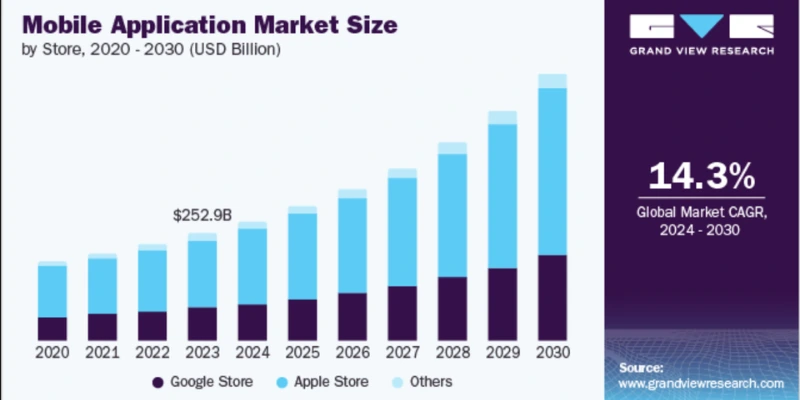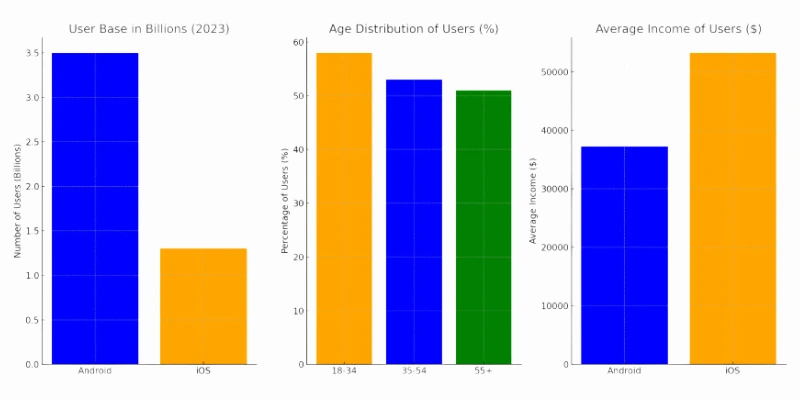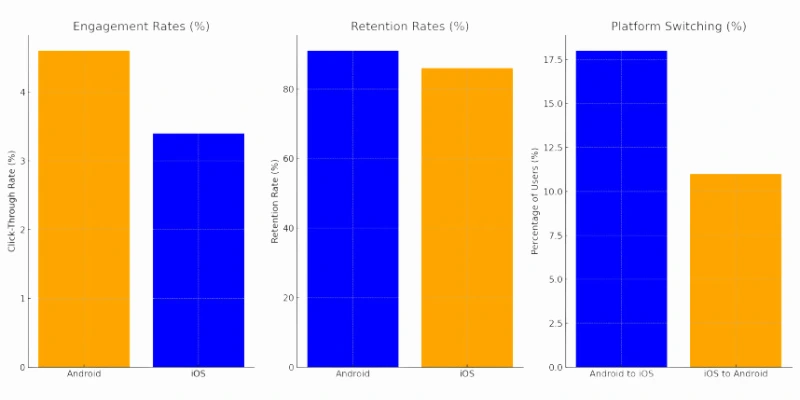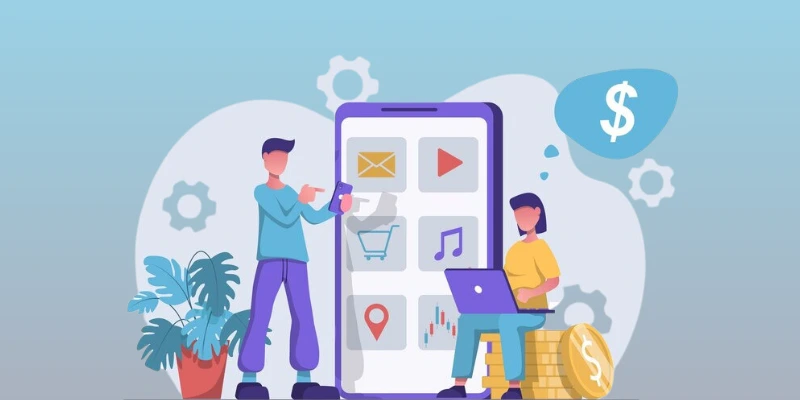The market for mobile apps is changing quickly and is expected to grow significantly over the next few years. According to Grand View Research, the world market for mobile apps was worth $252.89 billion in 2023. It is projected to grow at a rate of 14.3% per year from 2024 to 2030, and the need for Android and iOS app development services is also increasing with this growth. This growth is caused by more people getting computers, more people using the internet, and improvements in technologies like AI and machine learning.
For example, in 2023, the Apple App Store brought in over 62.8% of all worldwide income. This was due to better revenue rates from in-app sales and paid content. On the other hand, the Google Play Store is expected to grow a lot because it has many users and is nice to developers.
This article examines the factors that affect revenue and success in Android development and iOS app development in 2025. The results should help businesses make smart choices in a world that is becoming increasingly digital. Companies that want to improve their mobile plans and take advantage of market possibilities will need to understand these changes.
Market Overview
The mobile app market is currently in an active state, defined by strong growth and innovation. As of 2023, the global mobile application market was valued at approximately $208.5 billion, with forecasts showing it could reach $777.4 billion by 2032, growing at a compound annual growth rate (CAGR) of 14.4%.

This growth is driven by the increasing acceptance of smartphones, which have become common across various groups, and the rising demand for mobile applications in areas such as gaming, e-commerce, and social networking. This demand has raised a global need for expert Android and iOS app developers in the market.
Growth Trends in Mobile App Usage and Revenue Generation
Mobile app usage continues to rise, driven by breakthroughs in technology such as artificial intelligence (AI) and virtual reality (VR). The games area remains a major source of income, accounting for over 40% of the total market share in 2025.
In addition, income models have expanded, with in-app sales and subscriptions becoming common, especially on iOS platforms, where profit rates are higher due to user profiles that favor paid offerings.
Major Players: Android and iOS
The two main players in this environment are Android and iOS. As of early 2024, Android holds a strong world market share of approximately 71.65%, while iOS makes for about 27.62%.
This difference reflects Android's wider reach across different makers, like Samsung and Xiaomi, compared to Apple's exclusive environment. This also helps iOS app creators to work seamlessly.
Also Read: Explore What's New in Android 15
Key Statistics: Market Share and User Demographics
Global Market Share:
-
-
Android: 71.65%
-
iOS: 27.62%
-
User Demographics:
-
-
Over 3.5 billion people prefer Android devices worldwide.
-
Approximately 1.3 billion people utilize iOS devices.
-
Regional Preferences:
North America shows a taste for iOS, with a market share of around 61%, while Android leads in Asia and Africa. With this user base, developing iOS applications will be profitable.
Android vs. iOS: Revenue Generation
A. Revenue Models
The mobile app environment uses various income models, each with distinct benefits and challenges. The main models include:
-
-
In-App Purchases (IAP): This model allows users to buy fake goods or features within the app. It has become particularly popular in-game apps, where users can purchase improvements or extra material.
-
Subscriptions: Many apps offer subscription-based services, giving continued access to special material or features. This model has gained ground in areas like fun and efficiency.
-
Advertising: Free apps often profit from ads, earning revenue based on views or clicks. While this plan can generate hefty income, it may also degrade user experience.
-
Paid Downloads: Users pay a one-time fee to download the app. This model is less popular today due to the dominance of free apps with IAP or ad-based revenue.
-
Despite Android's bigger user base, iOS apps earn significantly more income across these models, particularly through payments and IAPs, indicating a desire among iOS users to spend more on apps.
B. Average Revenue Per User (ARPU)
Average Revenue Per User (ARPU) is an important measure for measuring revenue across platforms. As of 2023, iOS users earned an ARPU of nearly $47, compared to $20 for Android users. This difference shows that iOS users are more likely to make purchases and engage with paid content.
Insights into user buying habits show that iPhone users tend to have higher disposable incomes—on average, they earn about 43.7% more than their Android counterparts. This financial edge leads to greater spending on apps and services, making the iOS app and platform more valuable for creators.
Understanding the revenue model is difficult for some people; it is advised to consult with an expert iOS app development company like JPLoft for proper guidance.
C. Profitability Trends
Several popular apps illustrate the revenue trends between Android and iOS:
-
-
Fortnite: Initially launched on both platforms, it earned significantly higher income on iOS due to its in-app buy approach.
-
Netflix: The streaming service gets a large part of its income from iOS users, who are more likely to pay for paid services.
-
Projected income growth for both platforms suggests that while Android will continue to expand its user base, iOS is expected to maintain its lead in revenue creation. This makes it highly profitable to invest in iOS app development, as it can provide better ROI.
By 2026, customer spending on the Apple App Store is expected to hit $161 billion, compared to $72 billion on the Google Play Store. This trend suggests that companies targeting high-value customers may find greater success within the iOS environment, despite Android's bigger reach.
Also Read: How to Build an iOS App to Grow Your Business
User Demographics and Behavioral Insights
A. User Characteristics
The profiles of Android and iOS users show different trends formed by age, income, and tastes. Globally, Android holds a market share of approximately 70%, with over 3.5 billion users, while iOS accounts for around 30%, translating to about 1.3 billion users.

-
-
Age Distribution: Younger users tend to lean towards iPhones, with 58% of users ages 18-34 choosing iOS. In comparison, older groups show a taste for Android; for instance, 53% of users ages 35-54 support Android devices. This trend continues into the 55 and older group, where Android wins with 51%.
-
Income Levels: iPhone users usually have better salaries, making, on average, 43.7% more than their Android peers. For example, the average yearly income for iPhone users is around $53,251, compared to $37,040 for Android users. This economic difference affects buying habits, with iOS users more likely to invest in expensive apps and services.
-
Preferences: iOS is often viewed as a status sign, appealing to customers who value brand reputation and user experience. Conversely, Android's wide range of devices draws budget-conscious customers wanting value for money.
-
Also Read: iPhone 16's Cutting-Edge Features For Mobile App Development
B. Behavioral Insights
User involvement and trust trends on both platforms show key differences in behavior:

Engagement Rates: Android users show better responses to push messages, with a click-through rate of 4.6% compared to 3.4% for iOS users. This shows that Android apps may achieve better involvement through alerts.
Customer Loyalty: Both systems enjoy high retention rates; however, Android wins slightly with a retention rate of 91%, compared to iOS's 86%. Notably, 18% of iPhone users have moved from Android, while only 11% of Android users have made the reverse switch. This shows that while both user groups are loyal, iPhone users are more likely to try different platforms.
Influencing Factors: Key factors affecting user behavior include perceived security and user experience. A study showed that many customers feel more safe using Apple products due to Apple's image for privacy protection.
Furthermore, former Android users often claim better speed and usefulness as reasons for moving to iOS.
Development Costs and Time
When considering the development prices and time to market for mobile applications, several factors come into play that can greatly influence both aspects.
A. Cost of Development
The general costs involved with building apps can change widely based on several factors. The cost of mobile app development ranges from $25,000 to over $300,000, and it is affected by the app's complexity, feature set, and targeted platforms. You must understand the proper cost structure of mobile app development for the future.
Key Factors Influencing Development Costs:
-
-
App Complexity: More complex apps with advanced features like real-time data processing or third-party connections will cost more.
-
Design Requirements: Custom UI/UX design can greatly raise costs; easy designs may start at around $3,000, while complicated designs can exceed $70,000.
-
Platform Compatibility: Developing for both iOS and Android simultaneously (cross-platform) is usually more expensive than addressing a single device due to the need for multiple codebases.
-
In summary, approximately 70% of app development costs are determined by app complexity and platform compatibility, requiring cautious planning to keep expenses affordable while ensuring functionality. Hiring iOS developers from a reputed iOS app development company like JPLoft will be highly beneficial.
B. Time to Market
The usual time to start apps also changes between Android and iOS devices. Generally, making an iOS app tends to be easier due to Apple's more organized development environment and fewer device differences compared to Android.
-
-
iOS Apps: Depending on their complexity and features, they typically take 3-6 months to create and launch.
-
Android Apps: They may require a longer period of 4-8 months, partly because they need support across a wider range of devices and operating system versions.
-
Understanding these factors is important for companies looking to join the mobile app market successfully, as they directly affect both budget and timeline for the app launch.
Future Trends and Predictions for 2025
A. Emerging Technologies
The merging of Artificial Intelligence (AI), Augmented Reality (AR), Virtual Reality (VR), and the Internet of Things (IoT) is set to change the world of mobile app creation. These technologies are not only improving user interaction but also changing how applications are made and engaged.
-
-
Artificial Intelligence: It plays a key role in optimizing user experiences by studying data to adjust content and functions. AI-driven apps can learn from user behavior, giving suggestions that improve usefulness and happiness. For instance, AI can boost app speed by monitoring data and finding areas for growth, ensuring a smooth user experience. You must invest heavily in iOS app developers, as they can efficiently integrate features like AI.
-
-
-
Augmented Reality and Virtual Reality: These technologies are changing user interactions by giving realistic experiences that mix digital information with the real world.
-
AR apps are increasingly being used in shopping and education. They allow users to view goods in their surroundings or interact with learning materials in interesting ways.
-
VR, on the other hand, offers fully immersive experiences that are changing sectors such as games, real estate, and healthcare. As these technologies progress, they will become vital to app creation, opening the possibility of new apps that enhance user interaction.
-
Internet of Things: This technology allows apps to connect with different gadgets, enabling real-time data sharing and control. This connection allows for better apps that can automate chores and provide users with improved capabilities tailored to their needs.
-
For example, IoT-enabled apps can manage home control systems or track health data through linked devices, which can help in custom iOS app development.
B. Market Dynamics
Forecasts suggest a major change in market share trends between Android and iOS systems as we approach 2025. Android currently dominates with a larger global market share due to its extensive use across various devices.
-
-
iOS is expected to gain market share as Apple enhances its ecosystem with new features and a strong emphasis on user privacy.
-
The high-end segment of the app market is likely to favor iOS, driven by its affluent user base willing to invest in high-quality applications.
-
This trend may create a clearer distinction between the two platforms: Android is focuses on volume-driven strategies, while iOS targets premium user experiences.
-
The interplay of new technologies (AI, AR/VR, IoT) and evolving market dynamics will significantly influence the future of mobile app development.
-
These changes present exciting opportunities for mobile app developers and businesses to adapt and innovate in response to shifting trends.
-
Conclusion
In summary, the revenue and success of mobile app development rest on several key factors, including careful planning, knowing market trends, and leveraging new technologies. The merging of AI, AR/VR, and IoT is changing user experiences and business benefits.
The competitive environment between Android and iOS is changing, with iOS set to take a bigger part of the paid app market by 2025. Businesses must weigh these details to make knowledgeable choices that fit with their goals and target audience.
Ultimately, finding the right iOS app development company like JPLoft is crucial for turning ideas into great applications. Companies should value cooperation, experience, and a proven track record in the mobile app field. If you're considering creating an iOS app, choose JPLoft for expert advice and new solutions suited to your business needs. Connect with us today!












Share this blog